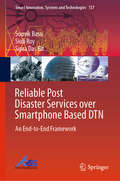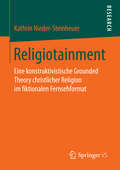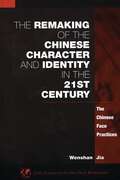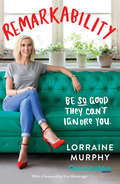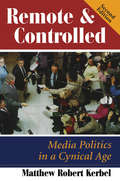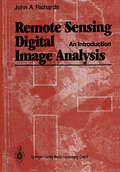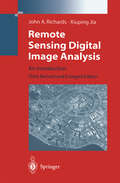- Table View
- List View
Reliability, Survivability and Quality of Large Scale Telecommunication Systems: Case Study: Olympic Games
by Peter StavroulakisCompetition within the telecommunications companies is growing fiercer by the day. Therefore, it is vital to ensure a high level of quality and reliability within all telecommunications systems in order to guard against faults and the failure of components and network services. Within large scale systems such quality and reliability problems are ever higher. The metrics of Quality and Reliability have to date only been available in journals and technical reports of companies which have designed or produced major parts of systems used in large applications. This book provides a self-contained treatment enabling the reader to be able to produce, define and utilise the metrics of Quality and Reliability required for the design and implementation of a large application such as a world class event as the Olympic Games. An additional outcome is that this book can be used as a guide for producing an ISO standard for large scale Systems such as the Olympic Games. * Provides presentations of techniques used for solving quality and reliability problems in telecommunications networks replete with illustrations of their applications to real-world services and world class events * Individual chapters written by respective international experts within their fields This will prove highly informative for Practising engineers, researchers and telecommunications professionals, academics and graduate students in telecommunications, standards bodies and organisations such as ISO.
Reliable Post Disaster Services over Smartphone Based DTN: An End-to-End Framework (Smart Innovation, Systems and Technologies #137)
by Souvik Basu Siuli Roy Sipra Das BitThis book proposes a framework and strategies for reliable end-to-end post-disaster services using smartphone-based delay-tolerant networks, which can operate even in the absence of conventional network connectivity. It explores various aspects of this challenge, ranging from accurate need assessment, to timely need accumulation, efficient resource allocation, and reliable data dissemination. The book offers insightful reading for all technologists and researchers working in the domain of ICT-based disaster management in developing countries, and will help them grasp the challenges involved in providing post-disaster services in an extremely difficult network scenario, while also offering possible solutions. The book will also benefit disaster management authorities, government agencies, NGOs and other stakeholders, helping them enhance their preparedness through the intelligent use of wireless technologies coupled with smart devices.
Religion, Ethnicity and Xenophobia in the Bible: A Theoretical, Exegetical and Theological Survey (Routledge Studies in the Biblical World)
by Brian RaineyReligion, Ethnicity and Xenophobia in the Bible looks at some of the Bible’s most hostile and violent anti-foreigner texts and raises critical questions about how students of the Bible and ancient Near East should grapple with "ethnicity" and "foreignness" conceptually, hermeneutically and theologically. The author uses insights from social psychology, cognitive psychology, anthropology, sociology and ethnic studies to develop his own perspective on ethnicity and foreignness. Starting with legends about Mesopotamian kings from the third millennium BCE, then navigating the Deuteronomistic and Holiness traditions of the Hebrew Bible, and finally turning to Deuterocanonicals and the Apostle Paul, the book assesses the diverse and often inconsistent portrayals of foreigners in these ancient texts. This examination of the negative portrayal of foreigners in biblical and Mesopotamian texts also leads to a broader discussion about how to theorize ethnicity in biblical studies, ancient studies and the humanities. This volume will be invaluable to students of ethnicity and society in the Bible, at all levels.
Religion, Ethnicity and Xenophobia in the Bible: A Theoretical, Exegetical and Theological Survey (Routledge Studies in the Biblical World)
by Brian RaineyReligion, Ethnicity and Xenophobia in the Bible looks at some of the Bible’s most hostile and violent anti-foreigner texts and raises critical questions about how students of the Bible and ancient Near East should grapple with "ethnicity" and "foreignness" conceptually, hermeneutically and theologically. The author uses insights from social psychology, cognitive psychology, anthropology, sociology and ethnic studies to develop his own perspective on ethnicity and foreignness. Starting with legends about Mesopotamian kings from the third millennium BCE, then navigating the Deuteronomistic and Holiness traditions of the Hebrew Bible, and finally turning to Deuterocanonicals and the Apostle Paul, the book assesses the diverse and often inconsistent portrayals of foreigners in these ancient texts. This examination of the negative portrayal of foreigners in biblical and Mesopotamian texts also leads to a broader discussion about how to theorize ethnicity in biblical studies, ancient studies and the humanities. This volume will be invaluable to students of ethnicity and society in the Bible, at all levels.
Religiöse Kommunikation und weltanschauliches Wissen: Kommunikative Konstruktionen unabweisbarer Gewissheiten und ihre gesellschaftlichen Wirkungen (Wissen, Kommunikation und Gesellschaft)
by Bernt Schnettler Thorsten Szydlik Helen PachDer Band exploriert die systematischen Bezüge zwischen Wissens- und Religionssoziologie. Zunächst enthält er daher die deutsche Erstübersetzung des klassischen Aufsatzes zu diesem Thema von Berger und Luckmann aus dem Jahr 1965. Das Spektrum der Beiträge umfasst aktuelle Forschungen über diverse Formen religiöser Kommunikation und weltanschaulichen Wissens aus drei Bereichen: Erstens empirische Studien zu religiösen und weltanschaulichen Kommunikationsgattungen, Veranstaltungsformen und Diskursen, zweitens Beiträge zu methodischen Zugriffen für die Analyse religiöser Kommunikation und die Weltanschauungs-analyse sowie drittens theoretische Beiträge zu wissenssoziologischen Aspekten religiösen und weltanschaulichen Wissens. Dabei werden soziologische sowie religionswissenschaftliche und linguistische Perspektiven eingenommen.Der InhaltWissens- und Diskursforschung • Staatliche Interventionen • Naturwissenschaft, Sinnkonstruktion und Weltanschauung • Erlösungskommunikation • Transformation religiöser Sinnresiduen • Gattungen der Sinnvermittlung • Rhetoriken der Normativität • Unsichtbare Religion in Massenereignissen Die Herausgeber*innenProf. Dr. Bernt Schnettler ist Inhaber des Lehrstuhls Kultur- und Religionssoziologie an der Universität Bayreuth. Thorsten Szydlik ist Wissenschaftlicher Mitarbeiter am Institut für Soziologie der Universität Marburg.Helen Pach ist Wissenschaftliche Mitarbeiterin am Lehrstuhl Kultur- und Religionssoziologie an der Universität Bayreuth.
Religiotainment: Eine konstruktivistische Grounded Theory christlicher Religion im fiktionalen Fernsehformat
by Kathrin Nieder-SteinheuerKathrin Nieder-Steinheuer hat ein Modell entwickelt, mit dem sich die kommunikative Verfasstheit der Kategorie des Christlichen im Unterhaltungsformat analysieren lässt. Grundlegend dafür ist der in den untersuchten Formaten festgestellte Zusammenhang zwischen kirchlichen Räumen und geographischen Konzepten einerseits und religiöser Normativität und statistisch-normalistischen Konzepten andererseits. Die bisherige theologisch dominierte Religiotainment-Forschung wird somit durch ein nicht normatives Analyseinstrument für die kulturelle Gegenwart des Christlichen im Unterhaltungsformat ergänzt.
Relikte der Strata: Beobachtungen zur Funktion kollektiver Identitäten
by Matthias MeierMatthias Meier geht der Frage nach, ob das Versprechen der Moderne, die ja auch als soziale Bühne für individuelle Selbstentfaltung gelesen werden kann, gesellschaftsstrukturell einer realistischen Beobachtung entspringt. Er legt dar, dass sich die Uneinlösbarkeit dieses Versprechens auch aus der Struktur einer in toto nichtadressierbaren Gesellschaft selbst ergibt - ein Umstand, der bislang durch gesellschaftliche Semantiken kollektiver Identitätsformen invisibilisiert werden konnte. Zudem untersucht der Autor, welche Funktionen diese Formen in einem soziologischen Sinne erfüllen und in welchen Kontexten sie sich als besonders anschlussfähig generieren. Dabei gewinnen im Zuge der Auflösung bislang als voraussetzbar angesehener Ordnungsmuster Figuren kollektiver Identitäten als Kontingenzlimitierungsformen auch neue Aktualität.
The Remaking of the Chinese Character and Identity in the 21st Century: The Chinese Face Practices (Civic Discourse for the Third Millennium)
by Wenshan JiaWenshan Jia demonstrates that a true liberation of Chinese civic discourse can start with a focus on indigenous cultural practices, such as face practices--the understanding that every human face offers a distinct cultural grammar for acting, speaking, and feeling. Chinese character and identity, the author argues, are primarily functions of communication, and as such, these practices are of enormous consequence to the necessary reconstruction of Chinese identity in the changing socioeconomic context of the 21st century. In this way, Jia finds a middle ground between the advocacy of complete Westernization and radical Chinese nationalism: as a pragmatic alternative, communication is key.Never before has facework research been approached so systematically from the standpoint of its relationship to character and identity. Jia's work substantially advances the literature on Chinese communication and presents a unique perspective on its relationship to social transformation. This new paradigm of facework--including analytical methods such as Circular Questioning in addition to major case studies--challenges traditional views while pointing the way toward a new and valuable social-constructionist view.
Remarkability
by Lorraine MurphyBe so good they can't ignore you. How to succeed at business and life by one of Australia's leading entrepreneurs and founder of The Remarkables Group.Success isn't made up of huge leaps forward, but instead small repetitive actions completed each day. These small steps eventually lead to great achievements in the pursuit of your goals. This book is an inspiring look at the lessons Lorraine has learned during her entrepreneurship journey - through study, trial and error; the strategies she has developed and the habits she religiously follows. Be remarkable in work and life, following the advice of one of Australia's most exciting thought leaders.
Remote Capture: Digitising Documentary Heritage in Challenging Locations (PDF)
by Jody Butterworth Andrew Pearson Patrick Sutherland Adam FarquharThis is a must-read how-to guide if you are planning to embark on a scholarly digitisation project. Tailored to the specifications of the British Library’s EAP (Endangered Archives Programme) projects, it is full of sound, practical advice about planning and carrying out a successful digitisation project in potentially challenging conditions. From establishing the scope of the project, via practical considerations about equipment, work routines, staffing, and negotiating local politics, to backing up your data and successfully completing your work, Remote Capture walks you through every stage. Bursting with helpful hints, advice and experiences from people who have completed projects everywhere around the globe from Latin America to Africa to Asia, this book offers a taste of the challenges you might encounter and the best ways to find solutions. With a particular focus on the process of digitisation, whether using a camera or a scanner, Remote Capture is invaluable reading for anybody considering such a project. It will be particularly useful to those who apply for an EAP grant, but the advice in these pages is necessary for anyone wondering how to go about digitising an archive.
Remote & Controlled: Media Politics in a Cynical Age (PDF)
by Matthew Robert KerbelGiven how the media portray the political system, how can we educate ourselves about politics without feeling alienated? The amount of information now available to the public about government is without precedent, and contemporary media bring the political action closer than ever before. But in an age when reports on the manipulative behavior and character flaws of public figures appear as frequently as coverage of policy issues, many people are tuning out.Remote and Controlled examines the issue of widespread cynicism in an era of abundant information, asking whether it is possible to consume a steady diet of mainstream media and still understand and respect the political process. Starting with central examples of television's political coverage and the media's focus on the president, the author explores a variety of media from newspapers and radio to MTV and computer networks and political events and institutions. Both electoral politics and governance are explored through examples that range from FDR's fireside radio chats and the Kennedy-Nixon television debates to Vietnam and Watergate, on up to Clinton's war room, Perot's infomercials, C-SPAN and Congress, and the Monica Lewinsky scandal.Against a historical backdrop of political, technological, and institutional change, the text raises critical questions for a society plugged into Rush, Oprah, and USA Today: How do the media both magnify and undermine the president? Can televised town meetings replace the real thing? How do politicians seek to control the flow of information, and what do the media do about it? Does the information explosion provide greater diversity or simply greater convenience? The second edition of this acclaimed text has been revised and updated to examine media coverage of recent events including the Monica Lewinsky scandal and other high-profile stories. In the process, the author sheds light on the ultimate dilemma of whether an informed public will participate in a system in which campaigns are portrayed as if they were war, policymaking is depicted as if it were a campaign, and none of the participants.
Remote Instrumentation and Virtual Laboratories: Service Architecture and Networking
by Franco Davoli Norbert Meyer Roberto Pugliese Sandro ZappatoreAccessing remote instrumentation worldwide is one of the goals of e-Science. The task of enabling the execution of complex experiments that involve the use of distributed scientific instruments must be supported by a number of different architectural domains, which inter-work in a coordinated fashion to provide the necessary functionality. These domains embrace the physical instruments, the communication network interconnecting the distributed systems, the service oriented abstractions and their middleware. The Grid paradigm (or, more generally, the Service Oriented Architecture -- SOA), viewed as a tool for the integration of distributed resources, plays a significant role, not only to manage computational aspects, but increasingly as an aggregator of measurement instrumentation and pervasive large-scale data acquisition platforms. In this context, the functionality of a SOA allows managing, maintaining and exploiting heterogeneous instrumentation and acquisition devices in a unified way, by providing standardized interfaces and common working environments to their users, but the peculiar aspects of dealing with real instruments of widely different categories may add new functional requirements to this scenario. On the other hand, the growing transport capacity of core and access networks allows data transfer at unprecedented speed, but new challenges arise from wireless access, wireless sensor networks, and the traversal of heterogeneous network domains. The book focuses on all aspects related to the effective exploitation of remote instrumentation and to the building complex virtual laboratories on top of real devices and infrastructures. These include SOA and related middleware, high-speed networking in support of Grid applications, wireless Grids for acquisition devices and sensor networks, Quality of Service (QoS) provisioning for real-time control, measurement instrumentation and methodology, as well as metrology issues in distributed systems.
Remote Instrumentation for eScience and Related Aspects
by Franco Davoli, Marcin Lawenda, Norbert Meyer, Roberto Pugliese, Jan Węglarz and Sandro ZappatoreThis book will focus on new Remote Instrumentation aspects related to middleware architecture, high-speed networking, wireless Grid for acquisition devices and sensor networks, QoS provisioning for real-time control, measurement instrumentation and methodology. Moreover, it will provide knowledge about the automation of mechanisms oriented to accompanying processes that are usually performed by a human. Another important point of this book is focusing on the future trends concerning Remote Instrumentation systems development and actions related to standardization of remote instrumentation mechanisms.
Remote Instrumentation Services on the e-Infrastructure: Applications and Tools
by Franco Davoli, Norbert Meyer, Roberto Pugliese and Sandro ZappatoreThe book focuses on all aspects related to the effective exploitation of remote instrumentation and to the building of complex virtual laboratories on top of real devices and infrastructures. These include service oriented architecture (SOA) and related middleware, high-speed networking in support of Grid applications, wireless Grids for acquisition devices and sensor networks, Quality Service (QoS) provisioning for real-time control, measurement instrumentation and methodology, as well as metrology issues in distributed systems.
A Remote Integrated Testbed for Cooperating Objects (SpringerBriefs in Electrical and Computer Engineering)
by Jose Ramiro Martinez-de Dios Adrian Jimenez-Gonzalez Alberto de San Bernabe Anibal OlleroTestbeds are gaining increasing relevance in research domains and also in industrial applications. However, very few books devoted to testbeds have been published. To the best of my knowledge no book on this topic has been published. This book is particularly interesting for the growing community of testbed developers. I believe the book is also very interesting for researchers in robot-WSN cooperation.This book provides detailed description of a system that can be considered the first testbed that allows full peer-to-peer interoperability between heterogeneous robots and ubiquitous systems such as Wireless Sensor Networks, camera networks and pervasive computing systems. The system architecture includes modules that allows full bidirectional communication between robots and WSN. One robot canThe book describes the current state of the art in development of testbeds integrating Cooperating Object technologies. It describes in detail the testbed specification and design using requirements extracted from surveys among experts in robotics and ubiquitous systems in academia and industry. The book also describes the testbed novel architecture and its hardware and software components. Moreover, it includes details on user support tools to facilitate its use such as remote use using a virtual private network and sets of functionalities of interest for members from the robotics, WSN and robot-WSN communities. Finally, the book illustrates its capabilities and potentialities describing the implementation of some of the experiments that have been performed. Examples from the robotics, WSN and robot-WSN communities are described.
Remote Patient Monitoring: A Computational Perspective in Healthcare (River Publishers Rapids Series in Biotechnology and Medical Research)
by Rishabha Malviya Priyanshi GoyalThis book provides a multidisciplinary overview of the design and implementation of systems for remote patient monitoring and healthcare. Readers are guided through the components of such a system and shown how they could be integrated into a coherent framework for deployment in practice. The book ends with a discussion of case studies to provide practical examples and design methods for remote healthcare systems with different needs. This book contains information that will be helpful to undergraduate and postgraduate students, academic and professional researchers, and individuals who employ computational intelligence. By presenting new models of care and support, AI in medicine is having an impact on the entire value chain of clinical practice and the patient care delivery system. This is especially evident in telemedicine breakthroughs, where applications of AI are utilized to assist, complement, or create new forms of remote healthcare. Through the use of communications technology, telemedicine enables medical professionals to examine, diagnose, and treat patients remotely. Now, the technology might also integrate online diagnostics, etc., to increase the effectiveness of the healthcare system and enhance patient outcomes. By enabling elderly people to live independently, technological advancements in fields like remote patient monitoring (RPM) systems can revolutionize senior care. Medical diagnosis will improve, and remote patient monitoring will become simpler thanks to artificial intelligence. The resistance of many patients and doctors to using the telemedicine idea for medical visits will probably be overcome by AI automation.
Remote Patient Monitoring: A Computational Perspective in Healthcare (River Publishers Rapids Series in Biotechnology and Medical Research)
by Rishabha Malviya Priyanshi GoyalThis book provides a multidisciplinary overview of the design and implementation of systems for remote patient monitoring and healthcare. Readers are guided through the components of such a system and shown how they could be integrated into a coherent framework for deployment in practice. The book ends with a discussion of case studies to provide practical examples and design methods for remote healthcare systems with different needs. This book contains information that will be helpful to undergraduate and postgraduate students, academic and professional researchers, and individuals who employ computational intelligence. By presenting new models of care and support, AI in medicine is having an impact on the entire value chain of clinical practice and the patient care delivery system. This is especially evident in telemedicine breakthroughs, where applications of AI are utilized to assist, complement, or create new forms of remote healthcare. Through the use of communications technology, telemedicine enables medical professionals to examine, diagnose, and treat patients remotely. Now, the technology might also integrate online diagnostics, etc., to increase the effectiveness of the healthcare system and enhance patient outcomes. By enabling elderly people to live independently, technological advancements in fields like remote patient monitoring (RPM) systems can revolutionize senior care. Medical diagnosis will improve, and remote patient monitoring will become simpler thanks to artificial intelligence. The resistance of many patients and doctors to using the telemedicine idea for medical visits will probably be overcome by AI automation.
Remote Sensing Digital Image Analysis: An Introduction
by John A. RichardsWith the widespread availability of satellite and aircraft remote sensing image data in digital form, and the ready access most remote sensing practitioners have to computing systems for image interpretation, there is a need to draw together the range of digital image processing procedures and methodologies commonly used in this field into a single treatment. It is the intention of this book to provide such a function, at a level meaningful to the non-specialist digital image analyst, but in sufficient detail that algorithm limitations, alternative procedures and current trends can be appreciated. Often the applications specialist in remote sensing wishing to make use of digital processing procedures has had to depend upon either the mathematically detailed treatments of image processing found in the electrical engineering and computer science literature, or the sometimes necessarily superficial treatments given in general texts on remote sensing. This book seeks to redress that situation. Both image enhancement and classification techniques are covered making the material relevant in those applications in which photointerpretation is used for information extraction and in those wherein information is obtained by classification.
Remote Sensing Digital Image Analysis: An Introduction
by John A. Richards Xiuping JiaRevised and enlarged to reflect new developments in the field, the fourth edition of this well-established text provides an introduction to quantitative evaluation of satellite- and aircraft-derived remotely retrieved data. Each chapter covers the pros and cons of digital remotely sensed data, without detailed mathematical treatment of computer based algorithms, but in a manner conductive to an understanding of their capabilities and limitations.
Remote Sensing with Imaging Radar (Signals and Communication Technology)
by John A. RichardsThis book is concerned with remote sensing based on the technology of imaging radar. It assumes no prior knowledge of radar on the part of the reader, commencing with a treatment of the essential concepts of microwave imaging and progressing through to the development of multipolarisation and interferometric radar, modes which underpin contemporary applications of the technology. The use of radar for imaging the earth’s surface and its resources is not recent. Aircraft-based microwave systems were operating in the 1960s, ahead of optical systems that image in the visible and infrared regions of the spectrum. Optical remote sensing was given a strong impetus with the launch of the first of the Landsat series of satellites in the mid 1970s. Although the Seasat satellite launched in the same era (1978) carried an imaging radar, it operated only for about 12 months and there were not nearly so many microwave systems as optical platforms in service during the 1980s. As a result, the remote sensing community globally tended to develop strongly around optical imaging until Shuttle missions in the early to mid 1980s and free-flying imaging radar satellites in the early to mid 1990s became available, along with several sophisticated aircraft platforms. Since then, and particularly with the unique capabilities and flexibility of imaging radar, there has been an enormous surge of interest in microwave imaging technology. Unlike optical imaging, understanding the theoretical underpinnings of imaging radar can be challenging, particularly when new to the field.
Renewing Rhetoric's Relation to Composition: Essays in Honor of Theresa Jarnagin Enos
by Shane BorrowmanRenewing Rhetoric’s Relation to Composition comprehensively examines the development of rhetoric and composition, using the writings of Theresa Jarnagin Enos as points of departure for studies of broader trends. Chapters explore such topics as the historical relations of rhetoric and composition, their evolution within programs of study, and Enos’s research on gender. The volume presents the growing disjunction between rhetoric and composition and paints a compelling picture of the current state of both disciplines as well as their origins. This volume acknowledges the influential role that Theresa Enos has had in the writing and rhetoric disciplines. Her career provides benchmarks for plotting developments in rhetoric and composition, including the evolving relations between the two. This collection offers a tribute to her work and to the new directions in the discipline stemming from her research. With an all-star line-up of contributors, it also represents the state of the art in rhetoric and composition scholarship, and it will serve current and future scholars in both disciplines.
Renewing Rhetoric's Relation to Composition: Essays in Honor of Theresa Jarnagin Enos
by Shane Borrowman Stuart Brown Thomas MillerRenewing Rhetoric’s Relation to Composition comprehensively examines the development of rhetoric and composition, using the writings of Theresa Jarnagin Enos as points of departure for studies of broader trends. Chapters explore such topics as the historical relations of rhetoric and composition, their evolution within programs of study, and Enos’s research on gender. The volume presents the growing disjunction between rhetoric and composition and paints a compelling picture of the current state of both disciplines as well as their origins. This volume acknowledges the influential role that Theresa Enos has had in the writing and rhetoric disciplines. Her career provides benchmarks for plotting developments in rhetoric and composition, including the evolving relations between the two. This collection offers a tribute to her work and to the new directions in the discipline stemming from her research. With an all-star line-up of contributors, it also represents the state of the art in rhetoric and composition scholarship, and it will serve current and future scholars in both disciplines.
Renovating Your Writing: Shaping Ideas and Arguments into Clear, Concise, and Compelling Messages
by Richard KallanRenovating Your Writing outlines the principles of effective composition by focusing on the essential skill set and mindset every successful writer must possess. Now in its second edition, this novel text provides readers with unique strategies for crafting and revising their writing, whether for school, work, or play. The new edition emphasizes, in particular, the importance of the writer embracing a rhetorical perspective, distinguishing between formal and social media compositional styles, and appreciating the effort needed to produce clear, concise, and compelling messages.
Renovating Your Writing: Shaping Ideas and Arguments into Clear, Concise, and Compelling Messages
by Richard KallanRenovating Your Writing outlines the principles of effective composition by focusing on the essential skill set and mindset every successful writer must possess. Now in its second edition, this novel text provides readers with unique strategies for crafting and revising their writing, whether for school, work, or play. The new edition emphasizes, in particular, the importance of the writer embracing a rhetorical perspective, distinguishing between formal and social media compositional styles, and appreciating the effort needed to produce clear, concise, and compelling messages.
Report Writing for Readers with Little Time (Routledge-Noordhoff International Editions)
by Rien Elling Bas A. Andeweg Christine Swankhuizen Jaap de Jong Kim van der LindenWriting reports is a vital skill in many professions and roles across every sector. Despite this, the majority of reports generated in organizations tend to be difficult to read, dull and do not make the impact they should - either for the content or for the author. In this book, you will learn how to write in a convincing way for a variety of different audiences. Fundamentals covered include structure, graphic presentation, plagiarism and oral presentation. The authors include a useful section on writing under pressure (by writing as a team, for example) as well as material on pitfalls to avoid when writing in English as a second language. This simple, effective book is a great tool for readers across the globe who wish to improve their report-writing skills.

